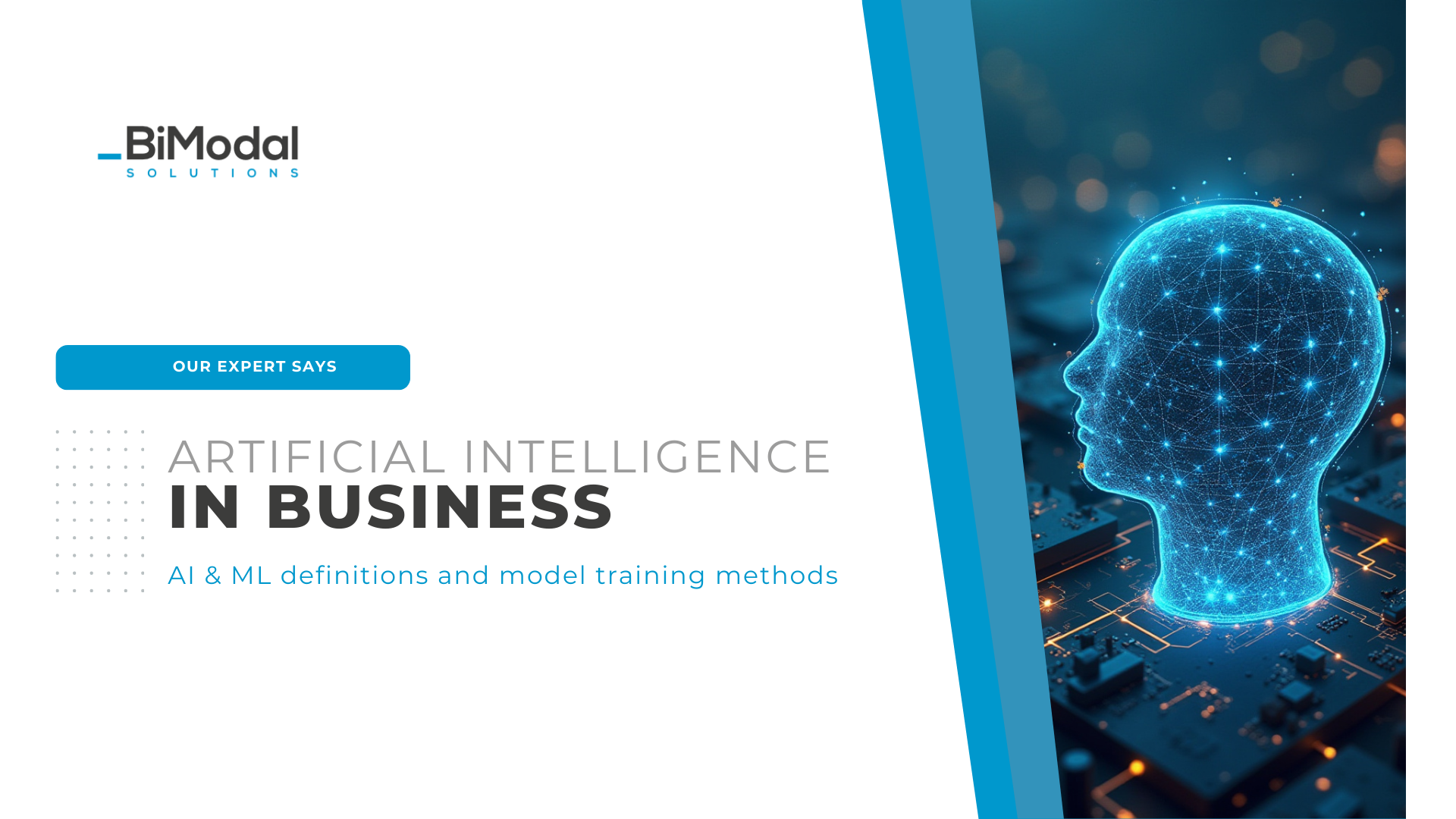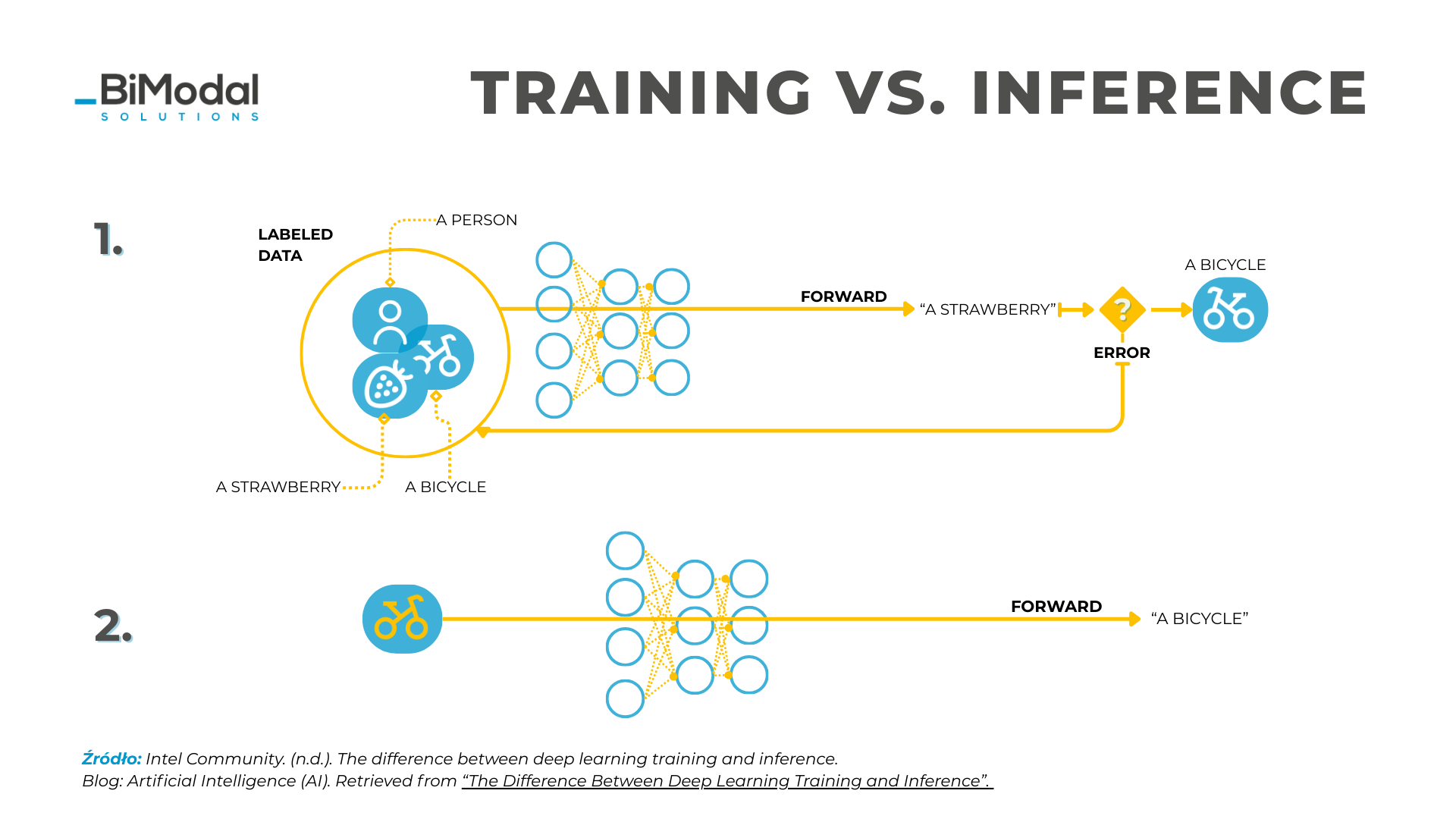Author: Arkadiusz Florek (Bimodal Planning team)
This article:
- Defines such terms as AI, ML, Deep Learning, AI model training, or inference.
- Highlights differences between the terms.
- Describes briefly what the AI algorithm training is about.
It is safe to say that AI has already become a permanent fixture in our daily lives and business. We almost instinctively reach for it to facilitate the repetitive, mundane tasks. This technology offers the precision of predictive analytics and the efficacy of information processing unparalleled by any alternative method.
The media hype surrounding this technology sometimes leaves entrepreneurs in a difficult position. Although we seem familiar with the terminology associated with artificial intelligence, sometimes people base their image of it on science fiction films, no less.
The objective of this article is to provide a clear definition of the fundamental concepts related to artificial intelligence and to illustrate its application in a business context. It provides answers to some key questions about AI and ML, defined as tools that we, as developers of Bimodal Solutions, use to meet business needs. We will also indicate the differences between the scientific fields dealing with AI algorithms to make our customers aware of the extent of our solutions' capabilities.
Chapter 1. What is AI?
AI - short for Artificial Intelligence - has become an omnipresent slogan. It appears everywhere, including our phones, favorite applications, and even in grocery stores.
However, what is it, exactly?
Artificial intelligence is a branch of computer science that aims to create machines capable of performing tasks that require the cognitive functions of human-like intelligence. It requires participation in a learning process, pattern recognition, decision-making, and even understanding natural-language processes.
Conclusion: AI is a sum of technologies that mimic human intelligence.
Chapter 2. What is Machine Learning?
If artificial intelligence is a broad term, the term "machine learning" (abbr. ML) is one of its key components. This word also experienced a vast surge in popularity. However, the question is: what does it mean, exactly?
Machine learning is a type of AI that allows computers to undergo a data-based learning process to train without human interference.
Note that: Machine learning is based on data. The more information algorithms receive, the more accurate their predictions will become.
Chapter 3: Difference between Machine Learning, Artificial Intelligence, and Deep Learning
Artificial intelligence is a vast field. Have you ever heard such terms as AI, ML, or DL? These terms are often used interchangeably, however. You could get confused - how do they differ from each other? Let's find out:
1. Artificial Intelligence (AI)
When we talk about AI vs Machine learning, the former is the broadest of the aforementioned terms. It describes all the computer systems that can perform tasks that would require human-like intelligence, including decision making, problem solving, or understanding natural language.
To think of AI is to compare it to the universe of intelligent machines. It includes everything - from basic, rule-based programs to more advanced, autonomous-learning systems.
2. Machine Learning (ML)
Machine Learning is a subset of AI. Machine learning focuses on teaching computers based on data, in contrast to creating programs manually.
Let's imagine that AI is a car. In that case, ML is the engine that drives it. Machine learning algorithms help AI improve over time through experience-based learning.
3. Deep Learning (DL)
Deep learning, in turn, is a subcategory of ML that imitates the human brain with neural networks.
If AI is a universe, and ML an engine, then DL can be compared to rocket fuel. It elevates the learning process to a completely different level thanks to processing huge data volumes.
How to train AI: input data versus inference
The terms "training" and "inference" in the context of ML and AI may sound a bit technical. However, both processes are based on a straightforward logic: first, software developers teach the model, and later on, they allow it to utilize the gathered knowledge.
The process of teaching the learning models is well-depicted below:
The training is the first stage of AI development. It may include a process of trial and error or delivering input data along with the expected results (i.e., output data) to the algorithm for its pattern recognition. The training process may also include both of these approaches.
The inference is the process that follows AI training. The more trained and fine-tuned machine learning models are, the better their inferences will be; however, there is never a guarantee that they will be perfect.
4. Conlusion: What is Artificial Intelligence and Machine Learning?
As you can see, the process of training the algorithm based on artificial intelligence happens real-world - and, in fact, is quite mundane. The application of AI and machine learning looks the same way each time we work with our clients. Due to that, the solutions we provide are data-driven, methodically tested, and based on thorough experience, thus reliable.
Next time, I will cover topics relating to the application of artificial intelligence technology in practice. Stay tuned for more practical insights on how to use AI and Machine Learning



